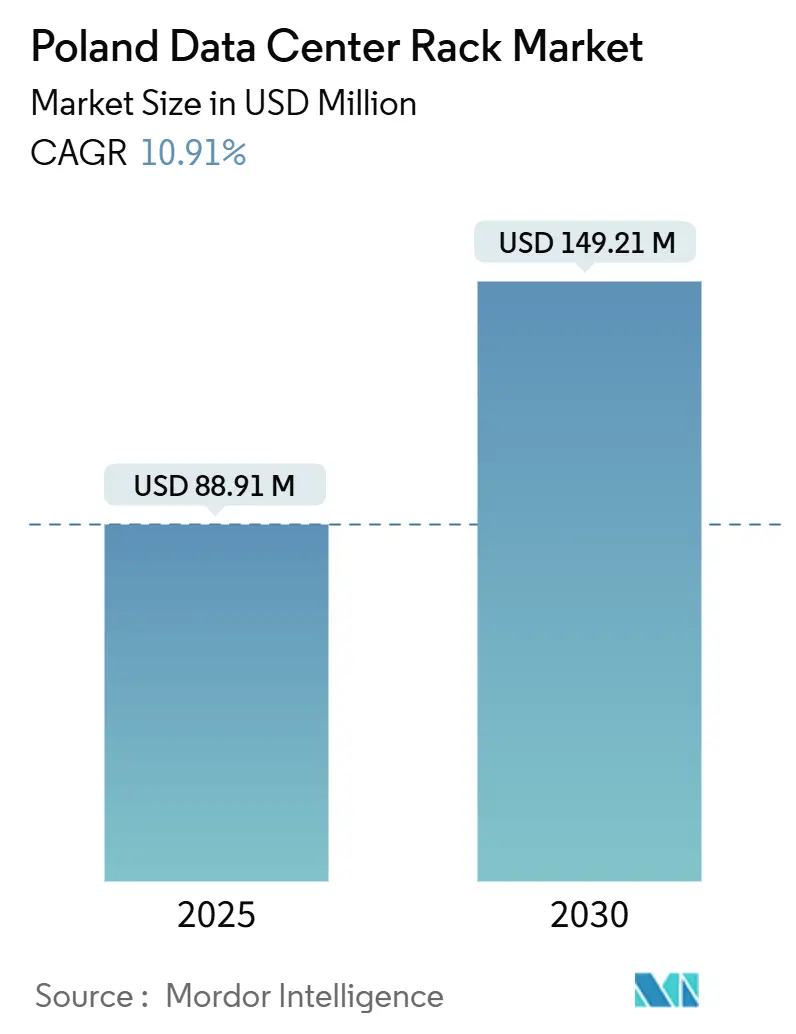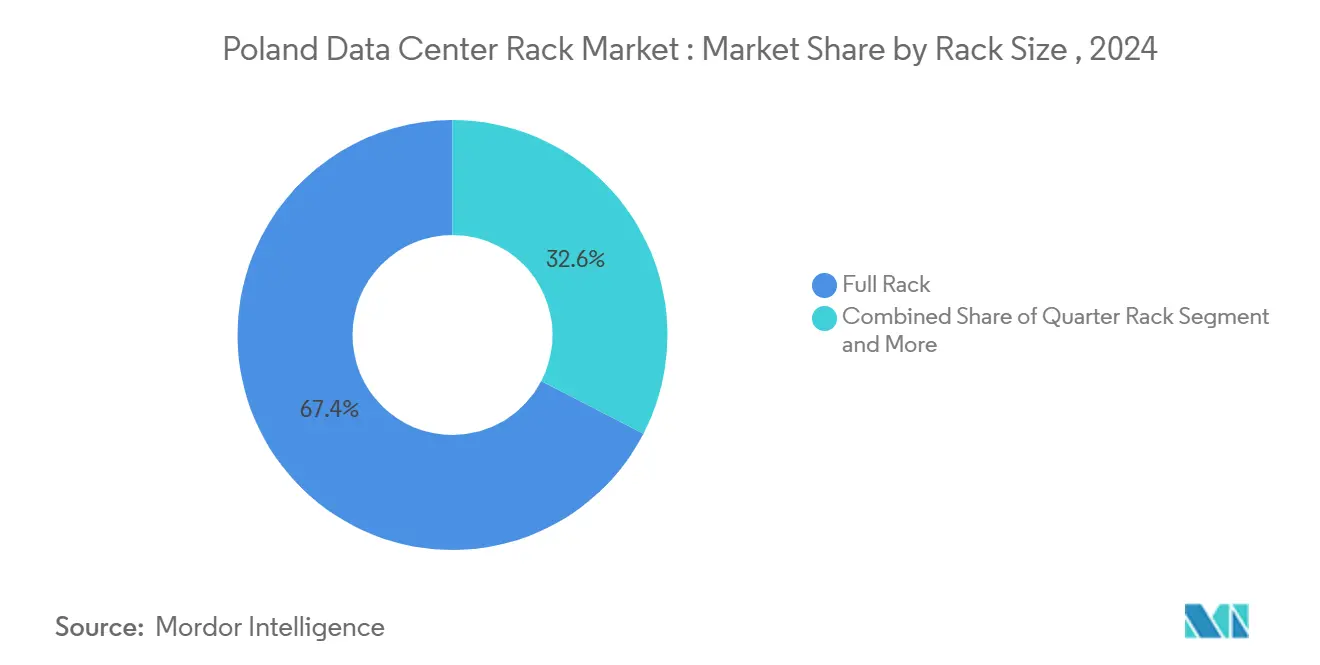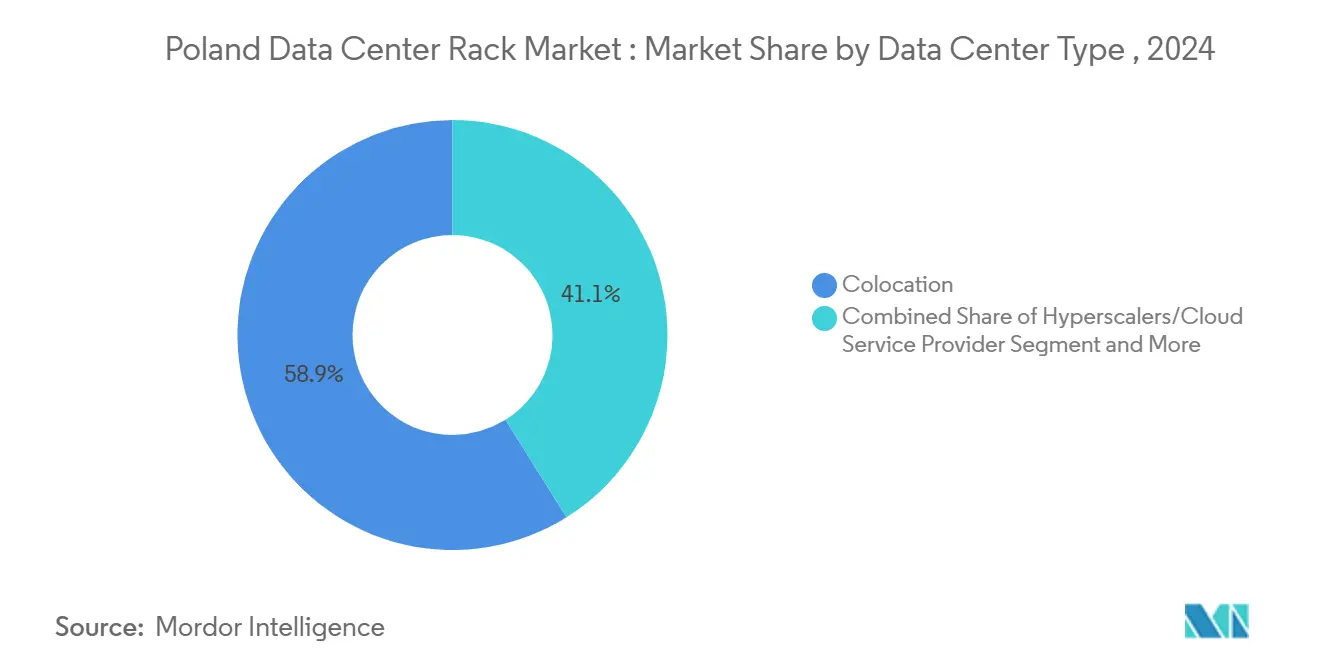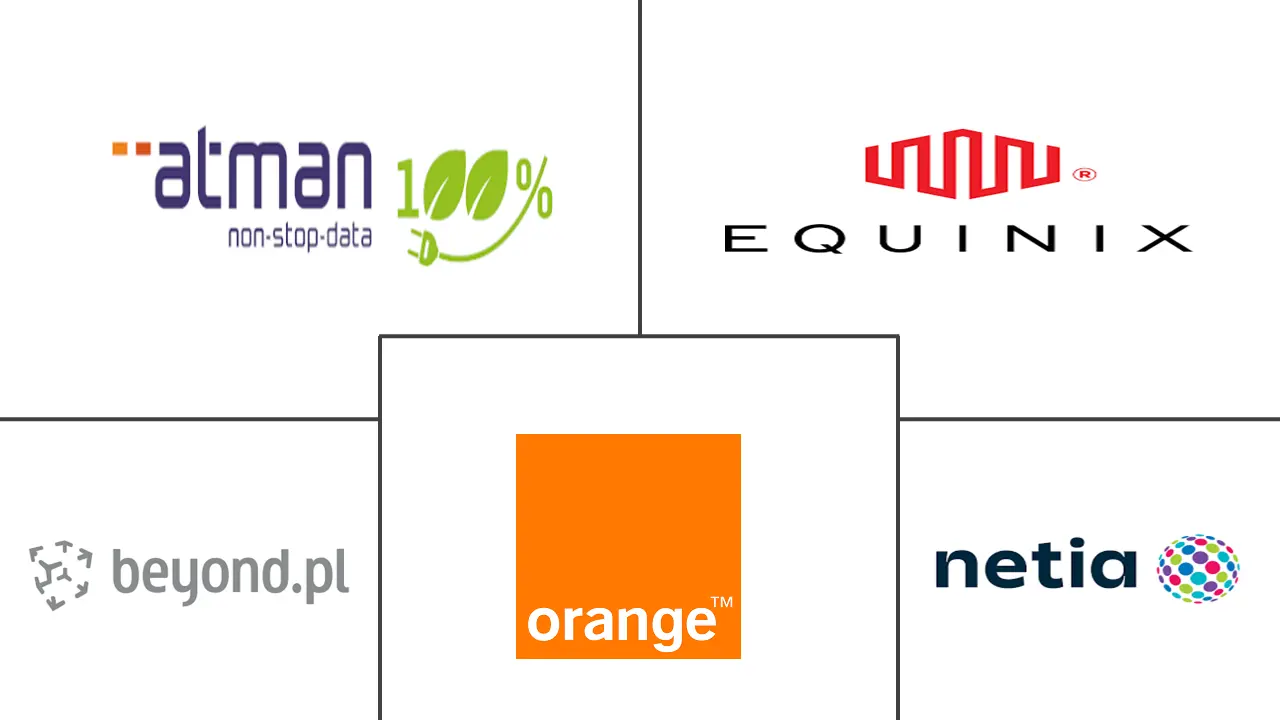Poland Data Center Rack Market Size and Share

Poland Data Center Rack Market Analysis by Mordor Intelligence
The Poland data center rack market is valued at USD 88.91 million in 2025 and is forecast to grow to USD 149.21 million by 2030, advancing at a 10.91% CAGR. Strong capital injections from hyperscalers—most notably Microsoft’s PLN 2.8 billion (USD 704 million) program—signal deep, long-term commitment to sovereign cloud infrastructure and support a sustained roll-out of high-density rack deployments.[1]Microsoft, “Microsoft announces PLN 2.8 billion investment in Polish cloud and AI infrastructure,” microsoft.com Rising compliance workloads linked to EU data-residency mandates, combined with enterprise digital-transformation funding earmarked within Poland’s EUR 149 billion Recovery and Resilience Facility allocation, are pushing organizations toward modern colocation campuses that can guarantee data-sovereignty, low latency and carrier neutrality. Secondary cities such as Krakow, Wrocław and Gdańsk are emerging as expansion targets as Warsaw’s grid-connection queue lengthens, while domestic operators collaborate through the Polish Data Center Association to address shared challenges in power, water and skills availability [2]Atman, “Polish Data Center Association formed to address sector challenges,” atman.pl.
Key Report Takeaways
- By rack size, full racks led with 67.4% of Poland data center rack market share in 2024; half racks recorded an 11.3% CAGR outlook to 2030.
- By rack height, 42U units accounted for 52.6% of the Poland data center rack market size in 2024, while 48U designs are projected to expand at 12.7% CAGR through 2030.
- By rack type, cabinet solutions captured 75.24% revenue share in 2024 and are advancing at an 11.8% CAGR to 2030.
- By data-center type, colocation facilities controlled 58.9% share in 2024, whereas hyperscale and cloud service provider locations post the fastest 13.2% CAGR through 2030.
- By material, steel frames commanded 84.6% of the Poland data center rack market size in 2024; aluminum alternatives are growing 12.1% annually on weight-reduction and thermal-efficiency priorities.
Poland Data Center Rack Market Trends and Insights
Drivers Impact Analysis
| Driver | % Impact on CAGR Forecast | Geographic Relevance | Impact Timeline |
|---|---|---|---|
| Rapid adoption of cloud services | +2.8% | National, concentrated in Warsaw and Krakow | Medium term (2-4 years) |
| Accelerated enterprise IT outsourcing | +2.1% | National, with early gains in Warsaw, Wrocław, Gdańsk | Short term (≤ 2 years) |
| Explosion in IoT and smart-device data | +1.9% | National, spill-over to regional centers | Long term (≥ 4 years) |
| EU sovereign-cloud compliance push | +1.7% | National, aligned with EU regulations | Medium term (2-4 years) |
| Edge-AI workload localisation | +1.4% | National, focused on major urban centers | Long term (≥ 4 years) |
| National Energy-Efficiency Tax Incentives | +1.2% | National, government-driven initiatives | Medium term (2-4 years) |
| Source: Mordor Intelligence | |||
Rapid Adoption of Cloud Services
Growth in regional availability zones from Google Cloud and Microsoft has triggered immediate demand for high-density racks, especially 48U cabinets engineered for GPU clusters that power AI training workloads. Hybrid architectures dominate enterprise migration roadmaps, blending hyperscale compute with on-premises edge nodes, and driving colocation providers to furnish carrier-neutral meet-me rooms that guard against vendor lock-in. Public-sector digitization programs funded through the EU facility are accelerating the pull toward these infrastructures, while manufacturers turn to cloud-based IoT platforms to embed predictive-maintenance routines that rely on steady edge-to-cloud throughput [3]International Trade Administration, “Poland’s digital transformation funding under EU Recovery Facility,” trade.gov.
Accelerated Enterprise IT Outsourcing
GDPR and the NIS2 Directive heighten the baseline for cyber-security and reporting, pushing resource-constrained firms to place sensitive workloads inside certified third-party facilities. Healthcare providers are moving clinical repositories into compliant clouds, and banks see operating-expenditure models as a route to Basel III capital-relief. Government-sponsored advisory portals help SMEs navigate outsourcing, yet 85% of organizations struggle to hire AI talent, intensifying the shift to managed-service contracts that bundle secure racks, interconnects and remote operations.
Explosion in IoT and Smart-Device Data
Smart-city pilots in Silesia and Lesser Poland rely on local processing to trim latency for traffic and environmental analytics, while heavy-industry plants stream machine telemetry into edge nodes tucked inside quarter-rack footprints. Pharmaceutical lines use on-site AI inference to meet audit-trail obligations, collectively increasing rack densities and cooling duty cycles, and spurring demand for containment solutions that sustain 24/7 uptime even when situated far from core metro power grids.
EU Sovereign-Cloud Compliance Push
The EU Data Boundary framework obliges providers to keep customer data within designated regions, compelling hyperscalers to expand Polish footprints and lifting uptake of locally owned racks. Enterprises in finance and healthcare exhibit heightened aversion to CLOUD Act exposure; 71% of surveyed IT leaders now flag foreign-authority access as a material risk, accelerating workload re-patriation to sovereign facilities.
Restraints Impact Analysis
| Restraint | % Impact on CAGR Forecast | Geographic Relevance | Impact Timeline |
|---|---|---|---|
| Rising data-security breach costs | -1.8% | National, concentrated in financial and healthcare sectors | Short term (≤ 2 years) |
| Limited skilled labour pool | -2.2% | National, acute in Warsaw and Krakow tech hubs | Medium term (2-4 years) |
| Grid-capacity bottlenecks near Warsaw | -1.6% | Warsaw metropolitan area, spillover to regional centers | Long term (≥ 4 years) |
| Surging water-usage restrictions | -1.1% | National, particularly acute in urban areas | Long term (≥ 4 years) |
| Source: Mordor Intelligence | |||
Rising Data-Security Breach Costs
CERT Polska logged 103,449 incidents in 2024, up sharply year-on-year, forcing operators to scale security outlays that inflate per-rack deployment costs. Insurance premiums for cyber-liability cover have jumped 40-60%, disproportionately pressuring smaller colocation vendors and nudging the market toward larger providers with in-house security operations centers.
Limited Skilled Labour Pool
Poland lacks 40,000-50,000 ICT specialists, with the shortfall biting hardest in data-center engineering, thermal design and cyber-defense posts. Operators are automating maintenance and installing AI-assisted remote-monitoring suites to mitigate staffing gaps, yet talent scarcity lengthens build-out schedules and slows the realisation of projected rack-deployment curves.
Segment Analysis
By Rack Size: Full Racks Drive Enterprise Adoption
Full racks captured 67.4% of Poland data center rack market share in 2024 and underpin the lion’s share of hyperscaler roll-outs, supporting AI clusters that pull 3-4× the power of conventional servers. This cohort expands at 11.3% CAGR through 2030 as Microsoft’s multi-site build program lifts demand for turnkey 48U cabinets that arrive pre-provisioned with busbars and rear-door heat exchangers. Half-rack and quarter-rack footprints remain relevant among SMEs that prioritise capex containment, particularly within distributed edge pods embedded in factories and logistics depots.
Second-tier manufacturers adopt half racks for regional disaster-recovery nodes, while urban small-office deployments favour quarter racks that tuck into co-working venues. The ripple effect is a diversified inventory model that allows colocation providers to sweat every square metre and elevate occupancy ratios. Poland data center rack market size for half-rack units is forecast to grow at 8.9% CAGR to 2030.

Note: Segment shares of all individual segments available upon report purchase
By Rack Height: 48U Configurations Gain Momentum
Traditional 42U assemblies continue to dominate with 52.6% share amid conservative enterprise refresh cycles, yet 48U frames register the sharpest 12.7% CAGR as AI-optimised designs climb vertically rather than horizontally to conserve floor space. Operators retro-fit hot-aisle containment and liquid-cool loops to sustain these taller stacks, generating incremental revenue from high-value accessories. Poland data center rack market size for 48U segments reaches USD 28.3 million by 2030, while Poland data center rack market share for 42U racks gradually declines to 46.2% as legacy equipment phases out.
Enterprises adopting private-cloud stacks lean toward 48U cabinets to consolidate compute and storage layers under a single roofline, capitalising on advances in cable-management trays that simplify top-of-rack switch access.
By Rack Type: Cabinet Solutions Dominate Security-Conscious Sectors
Cabinet racks claimed 75.24% share in 2024 thanks to enhanced physical-security and airflow management features prized by finance, healthcare and public-sector tenants tracking GDPR and NIS2 stipulations. Adoption accelerates at 11.8% CAGR as dense GPU trays necessitate sealed enclosures with door-mounted sensor arrays. Open-frame structures hold residual appeal inside locked white rooms or telecom shelters, and wall-mounted variants carve out a foothold in edge-compute closets that anchor smart-factory lines.
Operators upsell cabinet users on biometric access handles and rack-level environmental telemetry that feeds into AI-driven DCIM suites. Poland data center rack industry users note that automated locking mechanisms shorten audit cycles and reduce manual-check workloads.
By Data Center Type: Hyperscalers Lead Growth Acceleration
Colocation maintains majority share at 58.9% but cedes velocity to hyperscale and cloud-service facilities ascending at 13.2% CAGR. Standardised OCP-ready rack designs enable rapid deployment across Azure and Google Cloud campuses, lowering procurement costs and setting new benchmarks for energy-usage effectiveness. Poland data center rack market size inside hyperscaler footprints is set to double between 2025 and 2030 as EU data-sovereignty and latency commitments lock in local capacity reservations.
Enterprise edge build-outs complement the picture by anchoring AI inference engines and latency-sensitive IoT workloads inside on-prem pods, often in quarter-rack form factors connected back to Warsaw cloud nodes over low-latency dark fibre.

Note: Segment shares of all individual segments available upon report purchase
By Material: Steel Dominance Faces Aluminum Challenge
Steel frames ruled with 84.6% share in 2024 owing to price competitiveness and proven load-bearing reliability. Aluminum racks accelerate at 12.1% CAGR as operators weigh lower floor-loading, corrosion resistance and thermal-conductivity gains against higher upfront costs. Poland data center rack market size for aluminum units closes in on USD 14.2 million by 2030 as liquid-cool implementations exploit the alloy’s heat-dissipation edge.
Composite materials remain niche, confined to EMI-shield or offshore installations, yet ongoing R&D into carbon-fibre-reinforced panels could unlock new density thresholds if unit economics improve.
Geography Analysis
Warsaw anchors roughly one-third of Poland’s 120 live data-center facilities, drawing hyperscalers with its dense fibre mesh and clustering of skilled labour. The capital’s 142 MW installed base faces grid-connection wait times stretching several years, prompting operators to scope secondary metros. Krakow benefits from university talent pipelines, Wrocław leverages strong manufacturing ecosystems, and Gdańsk offers port-side subsea-cable landings that shorten paths to Nordic renewable power corridors.
Grid bottlenecks steer some projects toward Silesia, where legacy heavy-industry substations supply latent capacity. Cooler average temperatures across southern foothills cut mechanical-chiller runtime, translating into lower power-usage effectiveness scores relative to warmer EU peers. National clean-energy targets that envision 50% CO₂ reduction by 2030 nudge data-center buyers toward PPAs tied to wind and solar assets, yet Poland’s coal-heavy mix still inflates scope-2 emissions and may hamper international ESG ratings until renewable penetration accelerates.
Infrastructure policymakers plan three state-backed fibre-linked campuses by 2026 that will disperse workloads and lighten pressure on Warsaw’s over-subscribed grid. Water-consumption caps in populous counties intensify the pivot toward air-cooled or closed-loop designs, with ASHRAE W1-to-W4 envelopes guiding technology choices. Taken together, these geographic nuances create a multi-hub topology where hyperscalers anchor core regions while edge nodes pepper provincial industrial belts.
Competitive Landscape
The Poland data center rack market shows moderate concentration as domestic specialists Atman and Beyond.pl square off against global brands Equinix, Data4 and EdgeConneX. Local incumbents leverage regulatory fluency, Polish-language customer support and existing metro-ring footprints. Incoming multinationals inject capital depth and global partner ecosystems, accelerating adoption of OCP-compliant racks and AI-managed cooling systems.
Energy-efficiency and automation emerge as differentiation pillars. Operators deploy AI-based predictive maintenance to cut unplanned downtime, and retrofit containment aisles with variable-speed fans that adjust to 1-second thermal telemetry. Edge-focused white-space remains contested, with vendors crafting micro-data-center modules that integrate racks, in-row coolers and switchgear for factory floors.
Consolidation accelerates after the 2023 launch of the Polish Data Center Association, which lobbies for tax incentives, skills programmes and streamlined permitting. Equinix’s Polish IBX campuses pursue 100% renewable sourcing, while Beyond.pl markets 100% uptime SLAs and ISO 27701 privacy certification. Strategic alliances with cloud exchanges and network carriers enable bundled cross-connects that underpin hybrid-cloud architectures. Collectively, these moves raise the performance bar and shape buyer expectations for rack-level telemetry and sustainability credentials.
Poland Data Center Rack Industry Leaders
-
Atman Sp. z o.o.
-
Orange Polska S.A.
-
Equinix Inc.
-
Beyond.pl Sp. z o.o.
-
Netia S.A.
- *Disclaimer: Major Players sorted in no particular order

Recent Industry Developments
- February 2025: Microsoft invested PLN 2.8 billion (USD 704 million) to expand Polish cloud and AI infrastructure and partner with national defence agencies on cyber-resilience.
- February 2025: nVent Electric sold its Thermal Management unit to Brookfield for USD 1.7 billion to focus on electrical-protection offerings in data-center markets.
- December 2024: Beyond.pl unveiled its “Future Data Centers” programme highlighting energy-efficient, AI-ready campuses powered by renewables.
- November 2024: Schneider Electric posted record EUR 38.2 billion revenue, citing robust European data-center spending and AI-driven demand.
Research Methodology Framework and Report Scope
Market Definitions and Key Coverage
Our study views the Poland data center rack market as the annual value of newly manufactured steel or aluminum enclosures that hold servers, storage, and network gear inside purpose-built enterprise, colocation, edge, and hyperscale facilities. All form factors from quarter to full racks and both open-frame and cabinet designs are counted, expressed in USD at factory-gate prices.
Scope Exclusion: Telecom closets used in office buildings and retrofit containment add-ons were kept outside the scope because their buying drivers and pricing differ markedly.
Segmentation Overview
- By Rack Size
- Quarter Rack
- Half Rack
- Full Rack
- By Rack Height
- 42U
- 45U
- 48U
- Other Heights (?52U and Custom)
- By Rack Type
- Cabinet (Closed) Racks
- Open-Frame Racks
- Wall-Mount Racks
- By Data Center Type
- Colocation Facilities
- Hyperscale and Cloud Service Provider DCs
- Enterprise and Edge
- By Material
- Steel
- Aluminum
- Other Alloys and Composites
Detailed Research Methodology and Data Validation
Primary Research
Our team held interviews with colocation operators, rack integrators, and power-distribution specialists across Warsaw, Krakow, and Wroclaw. We then followed up with CIO surveys that revealed preferred rack heights, lead-time pain points, and expected price corridors. These conversations helped us confirm secondary findings and patch data gaps.
Desk Research
We pulled macro cues from Glowny Urzad Statystyczny, Eurostat, ENTSO-E power data, and the Office of Electronic Communications to gauge electricity tariffs, fiber reach, and cloud uptake. Shipment clues came from customs dashboards and Questel patent analytics, while Dow Jones Factiva and local trade press traced hyperscale build announcements. Company 10-Ks, investor decks, and notes from the Polish Chamber of Information Technology rounded out the picture. The sources named are illustrative only, and many further open datasets informed validation.
Market-Sizing & Forecasting
We began with a top-down reconstruction that multiplies installed IT load by average kilowatts per rack and by blended rack selling prices. These are then cross-checked with bottom-up supplier shipment samples and channel checks. Key variables feeding the multivariate regression include hyperscale capex pipelines, grid connection queues, average rack density, enterprise cloud spending, and steel cost indices. Scenario analysis covers currency shifts and energy-price shocks, and any missing shipment data is bridged through verified purchase-order extrapolation.
Data Validation & Update Cycle
Each model pass undergoes peer review; anomaly flags trigger re-contact with sources, and outputs are compared with independent trade and customs data. Mordor refreshes the model annually and issues interim updates when large campus announcements or regulatory moves alter demand assumptions. A final analyst sweep ensures clients get the freshest baseline.
Why Mordor's Poland Data Center Rack Baseline Commands Reliability
Published numbers often diverge because firms choose different rack mixes, price bases, and forecast horizons. By anchoring on verified IT-load metrics and refreshing assumptions yearly, Mordor Intelligence offers figures stakeholders can trace back to clear drivers.
Key gap drivers include: some publishers fold installation services into hardware totals, others lift Western Europe price points into Poland, and a few project aggressive hyperscale scenarios without accounting for local grid constraints.
Benchmark comparison
| Market Size | Anonymized source | Primary gap driver |
|---|---|---|
| USD 88.91 million (2025) | Mordor Intelligence | - |
| USD 380 million (2024) | Regional Consultancy A | Service revenue blended and Western Europe ASPs applied |
| USD 250 million (2024) | Global Consultancy B | Constant 15 kW-per-rack assumption ignores enterprise self-build share |
The comparison shows that our disciplined scope choices, multi-layer triangulation, and timely refresh cadence give decision makers a balanced, transparent baseline they can rely on.
Key Questions Answered in the Report
What is the size of the Poland data center rack market in 2025?
The market stands at USD 88.91 million in 2025 and is set to reach USD 149.21 million by 2030.
Which rack type leads in Poland?
Cabinet configurations dominate with 75.24% share due to strict security and environmental-control needs.
Why are 48U racks gaining traction
Taller 48U frames enable higher server density, supporting GPU-heavy AI workloads while saving valuable floor space.
How do grid bottlenecks affect new builds in Warsaw
Limited grid capacity can delay power connections by multiple years, prompting operators to develop in secondary cities.
Page last updated on:



